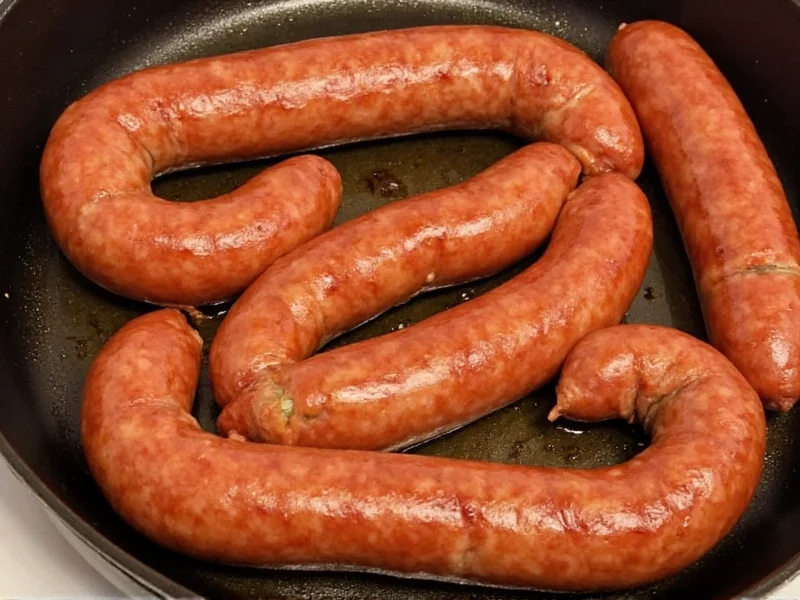Cooking Italian sausage in the oven delivers perfectly browned, juicy results with minimal effort compared to stovetop methods. This hands-off approach ensures even cooking without constant attention, making it ideal for weeknight dinners or meal prep. Unlike pan-frying which can create uneven browning or boiling which removes flavor, oven roasting concentrates the savory spices while rendering excess fat.
Essential Equipment and Ingredients
Before starting your Italian sausage oven recipe, gather these items:
| Equipment | Ingredients |
|---|---|
| Baking sheet or roasting pan | Italian sausage links (sweet or hot) |
| Parchment paper or aluminum foil | Olive oil (optional) |
| Meat thermometer | Pepper (optional) |
| Rimmed baking sheet (for juicy sausages) | Vegetables for one-pan meal (optional) |
Step-by-Step Oven Cooking Instructions
Preparation (3 minutes)
Remove Italian sausage from refrigerator 15-20 minutes before cooking to bring closer to room temperature. Line your baking sheet with parchment paper for easy cleanup—this prevents sticking without needing excess oil. If using a rimmed sheet, arrange sausages with space between them (about 1 inch) to ensure proper air circulation. For extra browning, lightly brush with olive oil and sprinkle with black pepper.
Oven Temperature and Positioning
Preheat your oven to 400°F (204°C) with the rack positioned in the center. This temperature provides the ideal balance between thorough cooking and developing a flavorful crust. Avoid higher temperatures which can cause casing to burst or lower temperatures that extend cooking time unnecessarily.
Cooking Process (25-30 minutes)
Place sausages in the preheated oven and cook for 15 minutes. Carefully turn each sausage using tongs, then continue baking for another 10-15 minutes. The exact time depends on sausage thickness—standard 1-inch links typically require 25 minutes total while thicker brat-style sausages may need up to 35 minutes.
Determining Doneness
The most reliable method for checking if Italian sausage is cooked is using an instant-read thermometer. Insert into the thickest part of a sausage—it should register 160°F (71°C). Visually, properly cooked sausage will have:
- Deep golden-brown exterior with slight blistering
- Firm texture that springs back when pressed
- No pink color in the center
- Clear juices (not pink)
Pro Tips for Perfect Results
Achieve restaurant-quality Italian sausage with these professional techniques:
Avoid Common Mistakes
- Don't overcrowd the pan - This creates steam instead of browning
- Don't skip turning - Ensures even cooking on all sides
- Don't pierce the casing - Releases flavorful juices
- Don't guess doneness - Always verify with thermometer
Flavor Enhancement Techniques
For deeper flavor when cooking Italian sausage in oven, try these methods:
- Add sliced onions, bell peppers, or potatoes to the pan for a complete one-pan meal
- Brush with garlic butter during the last 5 minutes of cooking
- Finish under the broiler for 2-3 minutes for extra caramelization
- Let sausages rest 5 minutes before serving to redistribute juices
Storage and Reheating Guidelines
Properly stored cooked Italian sausage maintains quality for:
- Refrigerator: 3-4 days in airtight container
- Freezer: 2-3 months when wrapped tightly
For best reheating results:
- Oven method: 350°F (177°C) for 10-15 minutes until heated through
- Air fryer: 325°F (163°C) for 5-7 minutes
- Avoid microwave which can make casings tough
Variations for Different Preferences
Customize your Italian sausage oven cooking method based on dietary needs:
- For crispier results: Start at 425°F (218°C) for first 10 minutes, then reduce to 375°F (191°C)
- For leaner sausage: Add 1 tablespoon olive oil to pan before cooking
- For gluten-free diets: Ensure sausage contains no breadcrumbs (check label)
- For meal prep: Cook sausages 75% done, then finish when serving
Frequently Asked Questions
Can I cook frozen Italian sausage in the oven?
Yes, but add 10-15 minutes to the cooking time. Place frozen sausages on the baking sheet and cook at 400°F (204°C) for 35-45 minutes, turning halfway through. Check internal temperature reaches 160°F (71°C) before serving. For best results, thaw sausages in the refrigerator overnight before cooking.
Why did my Italian sausage casing split in the oven?
Sausage casings typically split from rapid temperature changes or overfilling. To prevent this when cooking Italian sausage in oven, bring sausages to room temperature before baking, avoid high initial temperatures, and don't pierce the casing. If using homemade sausage, ensure proper filling without air pockets. Slight blistering is normal, but complete splitting indicates cooking issues.
How do I prevent Italian sausage from drying out in the oven?
To keep Italian sausage moist when oven cooking, don't overcook beyond 160°F (71°C), avoid piercing the casing, and consider baking on a bed of vegetables which creates steam. For particularly lean sausages, lightly brush with olive oil before baking. Let sausages rest 5 minutes after cooking to allow juices to redistribute before serving.
Can I cook Italian sausage and vegetables together in the oven?
Absolutely. For a complete meal when cooking Italian sausage in oven, arrange sliced onions, bell peppers, and potatoes around the sausages. Toss vegetables with 1 tablespoon olive oil, salt, and pepper. Add harder vegetables like potatoes first, then add sausages and softer vegetables after 10 minutes to ensure even cooking. This creates a flavorful one-pan dinner with minimal cleanup.
What's the difference between cooking Italian sausage in oven versus on stove?
Oven cooking provides more even browning with less attention required compared to stovetop methods. The oven's ambient heat cooks sausages uniformly without hot spots, while stovetop requires frequent turning. Oven method is better for cooking multiple sausages at once and creates less splatter. However, stovetop allows for immediate pan sauce creation using the rendered fat. Both methods yield delicious results when properly executed.











 浙公网安备
33010002000092号
浙公网安备
33010002000092号 浙B2-20120091-4
浙B2-20120091-4